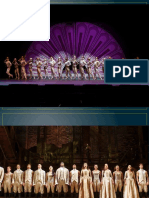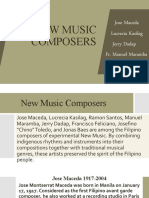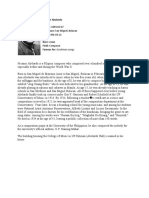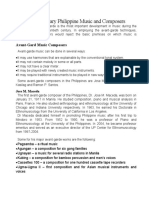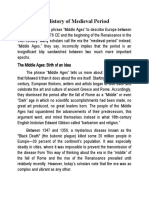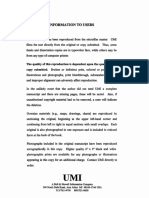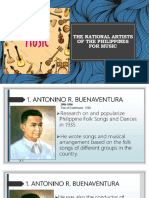Professional Documents
Culture Documents
Contemporary Philippine Music
Contemporary Philippine Music
Uploaded by
CHAPEL JUN PACIENTEOriginal Description:
Original Title
Copyright
Available Formats
Share this document
Did you find this document useful?
Is this content inappropriate?
Report this DocumentCopyright:
Available Formats
Contemporary Philippine Music
Contemporary Philippine Music
Uploaded by
CHAPEL JUN PACIENTECopyright:
Available Formats
CONTEMPORARY PHILIPPINE MUSIC
- According to National Artist Ramon Santos, PhD, “contemporary music in the Philippines refers to
compositions that have adopted ideas and elements from 20 th century art music in the west, as well as the
latest trends and musical styles in the entertainment industry.”
- The modern Filipino repertoire consists of musical pieces that have been written in 20th century idioms that
have evolved out of such stylistic movements as impressionism, expressionism, neo-classicism, as well as
avant garde and new music.
- New music are compositions which are improvisational works such as the early compositions of Dr. Ramon
Santos, Radyasyon and Quadrasyon; Josefino “Chino” Toledo’s Samut-Sari, Pintigan and Terminal
Lamentations, and Jonathan Baes’ Wala and Banwa.
20th CENTURY TRADITIONAL COMPOSERS
- With Spain and then America having colonized the Philippines from the early 1500s to the late 1800s, it was
unavoidable that Western compositional techniques found their way into the works of Filipino composers. Yet,
even 20th century Filipino composers have managed to retain some traditional elements in their assimilation of
Western techniques. In fact, they have become the strongest foundations of what we now know as Philippine
music.
Among the major Philippine contemporary composers are Francisco Buencamino Sr.,Francisco Santiago,
Nicanor Abelardo, Antonio Molina, Hilarion Rubio, Col. Antonino Buenaventura, Rodolfo Cornejo, Lucio San
Pedro, Rosendo Santos Jr., Alfredo Buenaventura, and Ryan Cayabyab.
Francisco Buencamino founded the Centro Escolar de Señoritas, Conservatory of Music. He also created the
Buencamino Music Academy in 1930. Nicanor Abelardo was one of his students. Expanding his career,
Buencamino also ventured into musical direction and scoring, composing music for Sampaguita Pictures, LVN,
and Excelsior. He also wrote several zarzuelas and kundiman. Francisco Santiago is known as the “Father of the
Kundiman” and belongs to the “Triumvirate of Filipino Composers.”
Nicanor Abelardo developed a style that combined European romanticism with chromaticism. He belongs to
the “Triumvirate of Filipino Composers” together with Francisco Santiago and Antonio Molina. The Tanghalang
Nicanor Abelardo (Main Theater) of the Cultural Center of the Philippines and the Abelardo Hall of the College
of Music, University of the Philippines are named after him. Antonio Molina came to be known as the “Father
of Philippine Impressionist Music,” while composer Lucio San
Pedro integrated indigenous musical forms, conventions, and instruments in his works in the modern
nationalistic style.
Hilarion Rubio was a Filipino composer, music teacher, conductor, and clarinetist. His name was closely
identified with his works for the orchestra, conductor for opera, ballet, dance recitals, and music for movies.
Col. Antonino Buenaventura promoted Philippine music by extensively using folk materials in his works. He
recorded folk and dance music around the country with Ramon Tolentino and National Artist for Dance
Francisca Reyes Aquino. Buenaventura composed the music and did the notations for the folk dances as
researched by Aquino.
Rodolfo S. Cornejo was considered “the first Filipino composer who received an honory degree from a
government recognized music school in the United States.” He was known for his “pianistic and compositional
talent” by extemporizing a piano composition at the spur of the moment. Felipe P. de Leon wrote piano
compositions, hymns, marches, art songs, chamber music, symphonic poems, overtures, band muSic, school
songs, orchestral works, operas, kundimans and zarsuelas. He was known as a nationalist composer who
expressed the Philippines' cultural identity through his compositions.
Lucio San Pedro is known as a “romantic nationalist.” He incorporated Philippine folk elements in his
compositions with Western forms and harmony. His chords have a rich expressive tonality, as represented in
his well-loved Sa Ugoy ng Duyan, a lullaby melody sung by his mother. Rosendo Santos Jr. is listed in the “New
Groves Dictionary of Music and Musicians.” A prolific composer, his works include concerti, sonatas,
symphonies, symphonic poems, five operas in Philippine dialect, numerous band overtures, and more than 200
marches. He wrote 50 masses in Latin and 20 in English. He has more than 1,000 musical compositions in the
library of the University of the Philippines.
Alfredo Buenaventura is among the few composers in the Philippines who composed five full-length operas.
He has his own set of ideas about music and composition. He created a combination of contemporary and
conventional, kept his melodies simple and understandable, but he used contemporary harmonies to suit the
intellectuals. Contemporary composer and conductor Ryan Cayabyab spans both popular and classical worlds
with his pop, ballads, operas, zarzuela, orchestral, and choral compositions.
You might also like
- Chandos Anthems 9 10Document3 pagesChandos Anthems 9 10Emmanuel Urom EzeNoch keine Bewertungen
- Week H - Embodied Spirit3Document3 pagesWeek H - Embodied Spirit3CHAPEL JUN PACIENTENoch keine Bewertungen
- 20th Century Traditional ComposersDocument90 pages20th Century Traditional ComposersJohn Paul M. DanaoNoch keine Bewertungen
- Characteristics of A Soap OperaDocument1 pageCharacteristics of A Soap Operaapi-267667213Noch keine Bewertungen
- SUMMARY Contemporary Music MAPEHDocument1 pageSUMMARY Contemporary Music MAPEHaeiaeiuao100% (1)
- 20th CENTURY TRADITIONAL COMPOSERSDocument48 pages20th CENTURY TRADITIONAL COMPOSERSByron Dizon100% (2)
- Contemporary Philippine MusicDocument14 pagesContemporary Philippine MusicSheila Marie U. RamirezNoch keine Bewertungen
- Lecture in Music 3Document4 pagesLecture in Music 3Sean CampbellNoch keine Bewertungen
- Music 10 Philippine Opera and Musical PlayDocument23 pagesMusic 10 Philippine Opera and Musical PlayPhilip Edward Calibjo NaritNoch keine Bewertungen
- HilarioDocument6 pagesHilarioApril Joy BartNoch keine Bewertungen
- Filipino Contemporary ComposersDocument4 pagesFilipino Contemporary ComposersSVÁNN YouTubeNoch keine Bewertungen
- Expressionism - A Bold New MovementDocument14 pagesExpressionism - A Bold New MovementJoseph Boyles100% (2)
- New Music ComposersDocument2 pagesNew Music ComposersCHAPEL JUN PACIENTE100% (1)
- Vocal and Dance Forms of Latin American MusicDocument21 pagesVocal and Dance Forms of Latin American MusicAlyssa Tammy Flores Ogoy100% (3)
- Primitivism and Neo ClassicismDocument11 pagesPrimitivism and Neo ClassicismKeshia Faith RizonNoch keine Bewertungen
- Grade 10 Arts LM 4Document19 pagesGrade 10 Arts LM 4chodie manansalaNoch keine Bewertungen
- Filipino Composers' BiographyDocument6 pagesFilipino Composers' Biographydalequinia100% (1)
- 20TH and 21ST Century Multimedia FormsDocument75 pages20TH and 21ST Century Multimedia FormsThea7378Noch keine Bewertungen
- Antonio Jesus Molina: of Contemporary MusicDocument11 pagesAntonio Jesus Molina: of Contemporary MusicGelene TampariaNoch keine Bewertungen
- Broadway and Philippine MusicalDocument12 pagesBroadway and Philippine Musicalfaber vb100% (1)
- MAPEHDocument2 pagesMAPEHJianamae DiamolaNoch keine Bewertungen
- New Music Composers: Jose Maceda Lucrecia Kasilag Jerry Dadap Fr. Manuel Maramba Ramon SantosDocument13 pagesNew Music Composers: Jose Maceda Lucrecia Kasilag Jerry Dadap Fr. Manuel Maramba Ramon SantosYAHIKOヤヒコYUICHIゆいちNoch keine Bewertungen
- D Epartment of E Ducation: Republic of The P HilippinesDocument46 pagesD Epartment of E Ducation: Republic of The P HilippinesARVEE DAVE GIPANoch keine Bewertungen
- JERRYDocument6 pagesJERRYJeovani OyananNoch keine Bewertungen
- Q4 Arts 10 Module 1Document13 pagesQ4 Arts 10 Module 1anthonneacNoch keine Bewertungen
- Physical Education 10 Las No.1 Week1 2 Fourth QuarterDocument2 pagesPhysical Education 10 Las No.1 Week1 2 Fourth QuarterTheresa Vasquez Vicente100% (1)
- Quarte 4 Week 8 Arts Grade 10Document4 pagesQuarte 4 Week 8 Arts Grade 10Jan Paul SantosNoch keine Bewertungen
- Francisco SantiagoDocument10 pagesFrancisco SantiagoHanna Maria SantianoNoch keine Bewertungen
- Learning Module Music 10 Quarter 3Document14 pagesLearning Module Music 10 Quarter 3WengNoch keine Bewertungen
- Lectures in Music Quarter IVDocument5 pagesLectures in Music Quarter IVMarissa Altarejos BrionesNoch keine Bewertungen
- Philippine Theater and Performing Groups 1Document2 pagesPhilippine Theater and Performing Groups 1GavinKarl MianabanataoNoch keine Bewertungen
- Original Performance With The Use of MediaDocument20 pagesOriginal Performance With The Use of MediaHarlene Dela Cruz OzarNoch keine Bewertungen
- Antonio Jesus MolinaDocument6 pagesAntonio Jesus MolinaAnnie Mangalindan100% (1)
- 20th and 21st Century Multimedia FormsDocument28 pages20th and 21st Century Multimedia FormsMARCI ALI BRIONESNoch keine Bewertungen
- 9 Arts (Playwrights)Document31 pages9 Arts (Playwrights)Dame Andrei PanoyNoch keine Bewertungen
- Mape 4Document9 pagesMape 4Aaron ReyNoch keine Bewertungen
- Media-Based Arts and Design in The PhilippinesDocument36 pagesMedia-Based Arts and Design in The PhilippinesEli Ayase100% (1)
- 3rd Q Music10Document23 pages3rd Q Music10Charlie Puth100% (1)
- Music 10 - Summative Test - 4th Final 10 ItemsDocument1 pageMusic 10 - Summative Test - 4th Final 10 ItemsLeil Riego100% (1)
- Filipino Composers and Their BiographiesDocument5 pagesFilipino Composers and Their Biographiestropical_pisces91% (32)
- The Teatro Zorrilla or Zorrilla TheatreDocument8 pagesThe Teatro Zorrilla or Zorrilla TheatreRosalinda ValgunaNoch keine Bewertungen
- Animation Print Media and Comic BooksDocument40 pagesAnimation Print Media and Comic BooksqwertasdfgNoch keine Bewertungen
- Quarter Iv 20TH and 21ST Century Multimedia FormsDocument5 pagesQuarter Iv 20TH and 21ST Century Multimedia FormsAngela Marie AmatiagaNoch keine Bewertungen
- Leopoldo Silos SRDocument1 pageLeopoldo Silos SRAlthea Nicole RodrinNoch keine Bewertungen
- Contemporary Philippine Music and ComposersDocument10 pagesContemporary Philippine Music and ComposersNixel MadiaNoch keine Bewertungen
- Sandugong PanaginipDocument3 pagesSandugong PanaginipArleneNoch keine Bewertungen
- 20th CENTURY TRADITIONAL COMPOSERSDocument2 pages20th CENTURY TRADITIONAL COMPOSERSMaryAnneAnaney100% (3)
- Q2 Music 10 - Module 4Document13 pagesQ2 Music 10 - Module 4Merry Pableo Hinedo100% (1)
- Philippine Musical PlayDocument28 pagesPhilippine Musical PlayBon Suriz L. LimpiadaNoch keine Bewertungen
- Grade 9 MAPEH - Romanticism ReportingDocument26 pagesGrade 9 MAPEH - Romanticism ReportingIonacer Viper100% (14)
- Arts 10 Q4 Module 1 Theater Arts Themes and Elements of Art Applied To PerformanceDocument19 pagesArts 10 Q4 Module 1 Theater Arts Themes and Elements of Art Applied To PerformancecharlottesimolataNoch keine Bewertungen
- Latin American Music Influence by African MusicDocument35 pagesLatin American Music Influence by African Musickitcath100% (1)
- Arts 1 Grade 10Document4 pagesArts 1 Grade 10Sean Campbell100% (1)
- Sample Activity Sheets in Music 10 Quarter 3, Week 1: MelcsDocument9 pagesSample Activity Sheets in Music 10 Quarter 3, Week 1: MelcsRachel Yam 3nidadNoch keine Bewertungen
- MapehDocument38 pagesMapehvenz golingo0% (1)
- Learning Activity Sheets: Music 10, Quarter 4, Week 1Document23 pagesLearning Activity Sheets: Music 10, Quarter 4, Week 1MARK JOSEPHNoch keine Bewertungen
- 2 Famous Operas of The Romantic PeriodDocument18 pages2 Famous Operas of The Romantic PeriodHymarVannTumimbang100% (1)
- Opera in The Philippines: Quarter IV: 20th AND 21st CENTURY Multimedia FormsDocument6 pagesOpera in The Philippines: Quarter IV: 20th AND 21st CENTURY Multimedia FormsGijoy Mangalas Lozano100% (2)
- First Grading Reviewer in MAPEH 10Document6 pagesFirst Grading Reviewer in MAPEH 10Melvin Manansala100% (1)
- MAPEH10 Impressionism Expressionism Neo-Classicism Avant-Garde and Modern Nationalism in MUSICDocument14 pagesMAPEH10 Impressionism Expressionism Neo-Classicism Avant-Garde and Modern Nationalism in MUSICRianne Araña100% (4)
- Music 10 Las Music of Latin AmericaDocument4 pagesMusic 10 Las Music of Latin AmericaDiayanara Rose CachoNoch keine Bewertungen
- Music 3.1 Traditional ComposersDocument12 pagesMusic 3.1 Traditional ComposersRad LixxNoch keine Bewertungen
- Untitled Document PDFDocument1 pageUntitled Document PDFJasmine AcostaNoch keine Bewertungen
- 4th GradingDocument7 pages4th GradingCHAPEL JUN PACIENTENoch keine Bewertungen
- Lesson 1Document18 pagesLesson 1CHAPEL JUN PACIENTENoch keine Bewertungen
- Q2 Week H - Transformation of Human RelationshipsDocument3 pagesQ2 Week H - Transformation of Human RelationshipsCHAPEL JUN PACIENTENoch keine Bewertungen
- 4th QuarterDocument5 pages4th QuarterCHAPEL JUN PACIENTENoch keine Bewertungen
- Q2 Week I - Meaning of LifeDocument4 pagesQ2 Week I - Meaning of LifeCHAPEL JUN PACIENTE100% (1)
- Decentralization and Local GovernmentDocument2 pagesDecentralization and Local GovernmentCHAPEL JUN PACIENTE100% (1)
- Week J - Prudence and FrugalityDocument4 pagesWeek J - Prudence and FrugalityCHAPEL JUN PACIENTE100% (1)
- Q2 Week F - The Human Person in SocietyDocument4 pagesQ2 Week F - The Human Person in SocietyCHAPEL JUN PACIENTENoch keine Bewertungen
- Q2 Week C - IntersubjectivityDocument11 pagesQ2 Week C - IntersubjectivityCHAPEL JUN PACIENTENoch keine Bewertungen
- Q2 Week Ab - Freedom of The Human PersonDocument9 pagesQ2 Week Ab - Freedom of The Human PersonCHAPEL JUN PACIENTENoch keine Bewertungen
- Patudan Es Youth Implementation PlanDocument2 pagesPatudan Es Youth Implementation PlanCHAPEL JUN PACIENTENoch keine Bewertungen
- Q2 Week G - Forms of Society and Social SystemsDocument4 pagesQ2 Week G - Forms of Society and Social SystemsCHAPEL JUN PACIENTENoch keine Bewertungen
- Week D - Opinion and TruthDocument7 pagesWeek D - Opinion and TruthCHAPEL JUN PACIENTENoch keine Bewertungen
- Week G - TranscendenceDocument4 pagesWeek G - TranscendenceCHAPEL JUN PACIENTENoch keine Bewertungen
- Q2 Week H - Being and DeathDocument3 pagesQ2 Week H - Being and DeathCHAPEL JUN PACIENTENoch keine Bewertungen
- Week I - The Human Person in Their EnvironmentDocument5 pagesWeek I - The Human Person in Their EnvironmentCHAPEL JUN PACIENTENoch keine Bewertungen
- Week e - Evaluate OpinionsDocument7 pagesWeek e - Evaluate OpinionsCHAPEL JUN PACIENTENoch keine Bewertungen
- Week B - Philosophical InquiryDocument6 pagesWeek B - Philosophical InquiryCHAPEL JUN PACIENTENoch keine Bewertungen
- Week C - Fact Vs OpinionDocument5 pagesWeek C - Fact Vs OpinionCHAPEL JUN PACIENTENoch keine Bewertungen
- Lifestyle and Weight ManagementDocument2 pagesLifestyle and Weight ManagementCHAPEL JUN PACIENTENoch keine Bewertungen
- Week F - Embodied Spirit1Document3 pagesWeek F - Embodied Spirit1CHAPEL JUN PACIENTENoch keine Bewertungen
- Week A - Doing PhilosophyDocument4 pagesWeek A - Doing PhilosophyCHAPEL JUN PACIENTENoch keine Bewertungen
- Music 4th GradingDocument4 pagesMusic 4th GradingCHAPEL JUN PACIENTENoch keine Bewertungen
- 4TH GradingDocument5 pages4TH GradingCHAPEL JUN PACIENTENoch keine Bewertungen
- Impressionism, Expressionism and CubismDocument2 pagesImpressionism, Expressionism and CubismCHAPEL JUN PACIENTENoch keine Bewertungen
- Surrealism, Abstract Expressionism, Pop Art, Op Art, Happenings and MobDocument4 pagesSurrealism, Abstract Expressionism, Pop Art, Op Art, Happenings and MobCHAPEL JUN PACIENTENoch keine Bewertungen
- Media Based ArtDocument5 pagesMedia Based ArtCHAPEL JUN PACIENTENoch keine Bewertungen
- IMPRESSIONISMDocument1 pageIMPRESSIONISMCHAPEL JUN PACIENTENoch keine Bewertungen
- New Music ComposersDocument2 pagesNew Music ComposersCHAPEL JUN PACIENTE100% (1)
- Concert Choir Program 2007Document8 pagesConcert Choir Program 2007John Kofi DadzieNoch keine Bewertungen
- Peking OperaDocument2 pagesPeking OperaHEVER TORRESNoch keine Bewertungen
- World Theatre Tradition BRITISH PANTOMIMEDocument1 pageWorld Theatre Tradition BRITISH PANTOMIMELeahBramleyNoch keine Bewertungen
- From The Age of Symbolism To Expressionism SymbolismDocument37 pagesFrom The Age of Symbolism To Expressionism SymbolismKatherine CosicoNoch keine Bewertungen
- Xv. Gimnazija Zagreb International Baccalaureate Diploma Programme Entrance Exam in English, Grade 11 SampleDocument9 pagesXv. Gimnazija Zagreb International Baccalaureate Diploma Programme Entrance Exam in English, Grade 11 SampleMarites Rojas-AlcazarNoch keine Bewertungen
- Mapeh (Four)Document26 pagesMapeh (Four)Tere Reyes VisteNoch keine Bewertungen
- Overture EssayDocument1 pageOverture EssaybenNoch keine Bewertungen
- Music: 1. Antonino BuenaventuraDocument5 pagesMusic: 1. Antonino BuenaventuraeyecandyNoch keine Bewertungen
- Assignment 8 Music History IIDocument2 pagesAssignment 8 Music History IIJay ShankarNoch keine Bewertungen
- Exoticism in Italian-Language Baroque OperaDocument18 pagesExoticism in Italian-Language Baroque OperaAvanti DeyNoch keine Bewertungen
- Quadern D'estiu Violi2022Document7 pagesQuadern D'estiu Violi2022marsalNoch keine Bewertungen
- AAM 4 - Cheat Sheets For ChromaticismDocument9 pagesAAM 4 - Cheat Sheets For ChromaticismLira KNoch keine Bewertungen
- Ae586 C PDFDocument23 pagesAe586 C PDFArtaria EditionsNoch keine Bewertungen
- Wagner Opera y DramaDocument8 pagesWagner Opera y DramaDaisuki HernándezNoch keine Bewertungen
- Grade 10 MusicDocument2 pagesGrade 10 MusicJeneva Rose PerezNoch keine Bewertungen
- Szymanowski List of CompositionsDocument12 pagesSzymanowski List of Compositionsdamdidam1Noch keine Bewertungen
- The Experimental Music of Pietro Raimond PDFDocument795 pagesThe Experimental Music of Pietro Raimond PDFAlex EmeryNoch keine Bewertungen
- 06 Horn 2Document5 pages06 Horn 2Alfonso Isaac Delgado ValenciaNoch keine Bewertungen
- Agrippina: Opera in Three ActsDocument16 pagesAgrippina: Opera in Three ActsInverted HumanNoch keine Bewertungen
- Pincherle & Marble 1938 Vivaldi and The Ospitali of VeniceDocument16 pagesPincherle & Marble 1938 Vivaldi and The Ospitali of VenicedhanemaayerNoch keine Bewertungen
- Module 11 MusicDocument34 pagesModule 11 MusicAllysa Shane Paningbatan RascoNoch keine Bewertungen
- Elsas Procession To The Cathedral InfoDocument9 pagesElsas Procession To The Cathedral InfoChristin ReillyNoch keine Bewertungen
- Information To UsersDocument236 pagesInformation To UsersMARIANoch keine Bewertungen
- Arts Handouts Fourth QuarterDocument3 pagesArts Handouts Fourth QuarterElton Martin de LeonNoch keine Bewertungen
- Vivaldi: Laudate Pueri Dominum, RV 600Document13 pagesVivaldi: Laudate Pueri Dominum, RV 600botmy banmeNoch keine Bewertungen
- Vivaldi: GloriaDocument10 pagesVivaldi: GloriaJean-Emmanuel AssemNoch keine Bewertungen
- 4th Adults - Mid Term - English File 3rd EditionDocument4 pages4th Adults - Mid Term - English File 3rd EditionwelcomevtNoch keine Bewertungen
- Family Trees TAREADocument1 pageFamily Trees TAREAOmarzinho Hualmayuno100% (1)



















